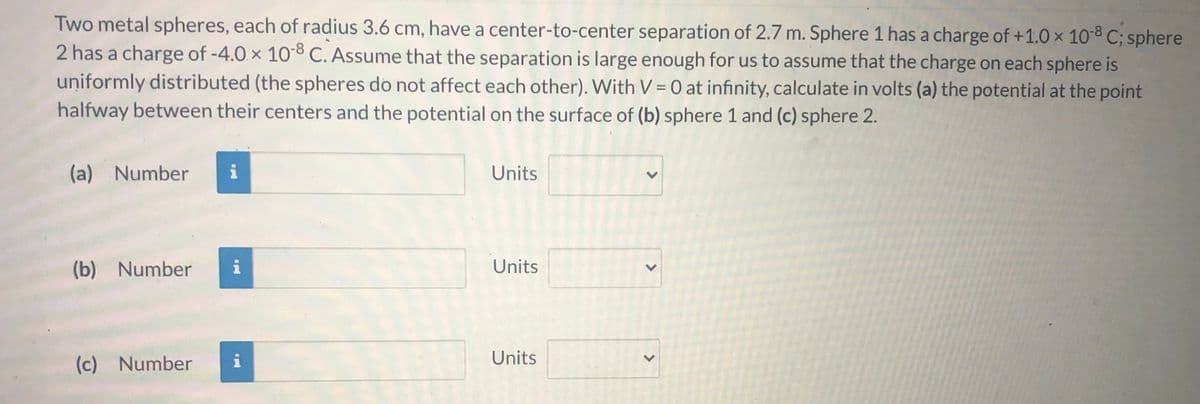Two metal spheres, each of radius 3.6 cm, have a center-to-center separation of 2.7 m. Sphere 1 has a charge of +1.0 x 108 C; sphere 2 has a charge of -4.0 x 108 C. Assume that the separation is large enough for us to assume that the charge on each sphere is uniformly distributed (the spheres do not affect each other). With V = 0 at infinity, calculate in volts (a) the potential at the point halfway between their centers and the potential on the surface of (b) sphere 1 and (c) sphere 2. (a) Number Units (b) Number Units (c) Number i Units
Two metal spheres, each of radius 3.6 cm, have a center-to-center separation of 2.7 m. Sphere 1 has a charge of +1.0 x 108 C; sphere 2 has a charge of -4.0 x 108 C. Assume that the separation is large enough for us to assume that the charge on each sphere is uniformly distributed (the spheres do not affect each other). With V = 0 at infinity, calculate in volts (a) the potential at the point halfway between their centers and the potential on the surface of (b) sphere 1 and (c) sphere 2. (a) Number Units (b) Number Units (c) Number i Units
Related questions
Question
Please type the final answer instead of writting

Transcribed Image Text:Two metal spheres, each of radius 3.6 cm, have a center-to-center separation of 2.7 m. Sphere 1 has a charge of +1.0 x 10-C; sphere
2 has a charge of -4.0 x 108 C. Assume that the separation is large enough for us to assume that the charge on each sphere is
uniformly distributed (the spheres do not affect each other). With V = 0 at infinity, calculate in volts (a) the potential at the point
halfway between their centers and the potential on the surface of (b) sphere 1 and (c) sphere 2.
%3D
(a) Number
i
Units
(b) Number
i
Units
(c) Number
i
Units
<>
<>
<>
Expert Solution
This question has been solved!
Explore an expertly crafted, step-by-step solution for a thorough understanding of key concepts.
This is a popular solution!
Trending now
This is a popular solution!
Step by step
Solved in 2 steps with 5 images
